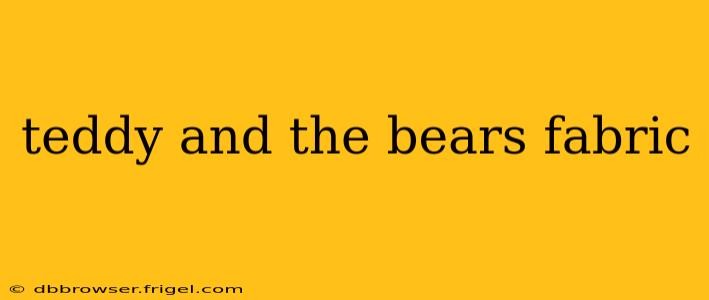Teddy bears have captivated hearts for generations, their cuddly charm transcending age and cultural boundaries. This enduring appeal extends to the fabrics used to create these beloved companions. From the softest velvets to the most durable cottons, the fabric of a teddy bear significantly contributes to its unique character and longevity. This guide delves into the world of teddy bear fabrics, exploring their history, common types, and the qualities that make them ideal for crafting these cherished toys.
What Fabrics are Typically Used for Teddy Bears?
Teddy bear creation utilizes a diverse range of fabrics, each offering unique qualities in terms of texture, durability, and cost. Some of the most popular choices include:
-
Mohair: Known for its luxurious softness and subtle sheen, mohair is a popular choice for high-end teddy bears. Its resilience makes it durable enough to withstand years of hugs and cuddles. However, it's also relatively expensive.
-
Alpaca: Similar to mohair in terms of softness and durability, alpaca wool offers a unique warmth and luxurious feel. It’s often chosen for its hypoallergenic properties and beautiful natural colors.
-
Cotton: A widely accessible and affordable option, cotton provides a durable and easy-to-clean fabric for teddy bears. It’s available in a vast array of colors and patterns, offering great versatility for crafting.
-
Velvet: Velvet adds a touch of elegance and richness to teddy bears. Its smooth, plush texture makes it incredibly soft and inviting. Different types of velvet, such as corduroy, offer variations in texture and weight.
-
Plush: A synthetic fabric, plush is known for its softness and affordability. It's a popular choice for mass-produced teddy bears due to its ease of production and cost-effectiveness.
-
Faux Fur: Offering a realistic fur-like texture without the use of animal products, faux fur is a popular and ethical alternative for teddy bear creation. A wide variety of colors and textures are available.
What Makes a Fabric Suitable for Teddy Bear Making?
The ideal fabric for a teddy bear should possess several key characteristics:
-
Softness: The fabric should be soft and gentle against the skin, ensuring a comfortable and enjoyable tactile experience.
-
Durability: Teddy bears are often subjected to rough handling, so the fabric needs to be durable enough to withstand repeated washing and play.
-
Washability: Easy cleaning is essential for maintaining hygiene. The fabric should be machine washable or easily spot-cleaned.
-
Colorfastness: The colors should resist fading and bleeding, ensuring the bear maintains its vibrant appearance over time.
How to Choose the Right Fabric for Your Teddy Bear Project?
The choice of fabric depends on several factors, including:
-
Budget: Mohair and alpaca are premium options, while cotton and plush are more budget-friendly.
-
Desired Look and Feel: Do you want a luxurious, plush bear or a more rustic, vintage-style one?
-
Skill Level: Some fabrics are easier to work with than others. Beginners might find cotton or plush more manageable.
-
Intended Use: A bear meant for a child might benefit from more durable and washable fabrics.
What are Some Alternatives to Traditional Teddy Bear Fabrics?
While traditional fabrics remain popular, creativity knows no bounds! Consider exploring other textiles like:
-
Knitted fabrics: Offer a unique texture and warmth.
-
Fleece: A soft and cozy option, especially suitable for winter bears.
-
Denim: A robust and durable choice for a more rugged teddy bear design.
Where Can I Find Teddy Bear Fabrics?
Specialty fabric stores, online retailers, and craft supply shops often carry a wide variety of teddy bear fabrics. Online marketplaces can also offer a broader selection and potentially better prices.
By carefully considering the characteristics and properties of different fabrics, you can select the perfect material to bring your teddy bear creation to life, ensuring a treasured companion for years to come. Remember to always pre-wash your fabric before starting your project to avoid shrinkage and color bleeding.
